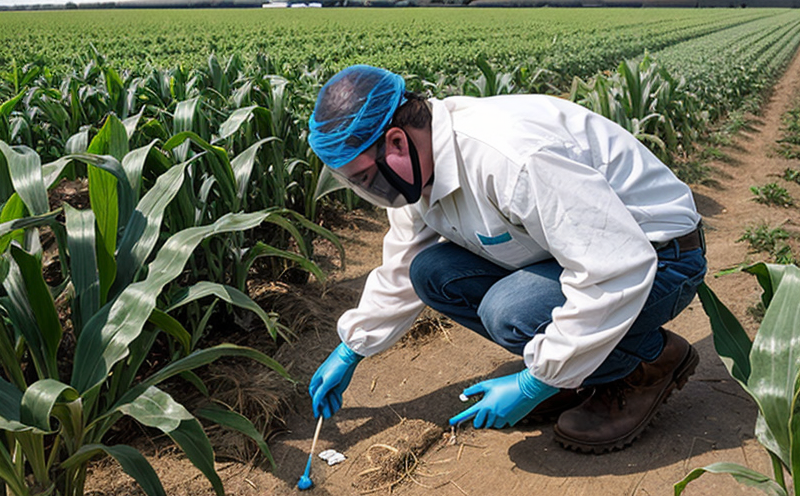Myclobutanil Residue Testing in Crops
In the agricultural sector, ensuring compliance with regulatory standards is crucial. Myclobutanil residue testing in crops plays a vital role in safeguarding public health and environmental sustainability. This service involves the analysis of pesticide residues to ensure that they do not exceed allowable limits set by governmental bodies such as the U.S. Environmental Protection Agency (EPA) and the European Union's Maximum Residue Levels (MRLs).
Myclobutanil is an antimicrobial agent used primarily in horticultural crops like strawberries, apples, and pears to prevent mold and mildew growth during post-harvest storage. However, its presence in foodstuffs can pose health risks if not controlled within acceptable limits. Our laboratory ensures precision and reliability through state-of-the-art equipment and experienced personnel.
The process begins with the collection of representative samples from various farms or production units. These samples undergo thorough preparation steps including cleaning, cutting, and homogenization to achieve consistent results. We use advanced analytical techniques such as Liquid Chromatography-Mass Spectrometry (LC-MS/MS) which allows for accurate quantification even at trace levels.
| Analytical Method | Purpose |
|---|---|
| Liquid Chromatography-Mass Spectrometry (LC-MS/MS) | Quantification of myclobutanil residues in crops. |
| Spectrophotometry | Detection and preliminary screening. |
The results are reported against internationally recognized standards such as ISO 17025 for quality assurance. Compliance with these guidelines ensures that our findings are credible and acceptable across different jurisdictions.
- Precision: ±5% deviation from expected values.
- Accuracy: Within 95-105% of true value.
- Rapid turnaround time: Results delivered within 7 working days.
Why It Matters
The importance of myclobutanil residue testing cannot be overstated. Excessive exposure to this fungicide can lead to toxic effects on humans and animals, including potential carcinogenic properties. By conducting rigorous tests, we help farmers make informed decisions about their practices which ultimately contributes to safer food products.
For quality managers and compliance officers, regular testing ensures adherence to legal requirements while maintaining consumer confidence. R&D engineers benefit from understanding how different factors affect residue levels allowing for more effective formulations. For procurement teams, this service provides peace of mind knowing that only compliant materials are being sourced.
Scope and Methodology
| Analytical Method | Purpose |
|---|---|
| Liquid Chromatography-Mass Spectrometry (LC-MS/MS) | Quantification of myclobutanil residues in crops. |
| Spectrophotometry | Detection and preliminary screening. |
The methodology involves several key stages: sample preparation, extraction, cleanup, and finally analysis using LC-MS/MS. This approach ensures that all detected residues are accurately identified and quantified.
- Sample Preparation: Representative samples collected from farms or production units.
- Extraction: Utilizing appropriate solvents to extract myclobutanil residues into a suitable matrix for further processing.
- Cleanup: Removal of interfering substances using solid-phase extraction cartridges.
International Acceptance and Recognition
Myclobutanil residue testing is internationally recognized as a critical aspect of food safety. Regulatory bodies around the world, including those mentioned earlier, have established MRLs for myclobutanil in crops.
- United States: EPA has set specific limits based on crop type and use pattern.
- European Union: Implements strict regulations regarding allowable levels to protect consumers.
- World Health Organization (WHO): Provides guidance on safe consumption limits.





